Disclaimer: links to web sites are ever-changing.
It turns out to be a Sisyphus task to keep them updated all the
time.
Therefore, either try a different "spelling" of the hyperlink, look for
it
on google.com and/or let me know about an outdated link by writing an
e-mail
to aveh@wncc.net .
see especially: Telescopes by
Nick Strobel (http://www.maa.mhn.de/Scholar/telescopes.html) and Orion Telescope
Center
(http://www.telescope.com/default.asp?page=Technical/Choosing_Telescope.html).
Telescopes
In order to do meaningful astronomy, it's imperative that we keep
the sky as dark as possible. Thus I promote the work of the International Dark-Sky Association .
 Every telescope has a finder
(also called spotting scope). You
need to start out with this to find the right object (makes
sense,
right?). The finder gives you a wider field of view: Since
stars
etc. move slower through the field when you slew the telescope, it's
easier
to point at the right star/ planet/ nebula/ galaxy. Every telescope has a finder
(also called spotting scope). You
need to start out with this to find the right object (makes
sense,
right?). The finder gives you a wider field of view: Since
stars
etc. move slower through the field when you slew the telescope, it's
easier
to point at the right star/ planet/ nebula/ galaxy.
Looking through the telescope magnifies more than the finder does,
giving therefore a smaller field of view. Stars etc. move
faster and it would be very tricky to find a particular object.
When pointing at an object, you must place it into the middle of the
finder's field. Then you will see it through the telescope as well, if
...
... can you see why finder and telescope should be perfectly aligned?
|
- Mount -> to stabilize
telescope
(type 1: alt.-azimuth; type 2: equatorial -> easier tracking of
objects)
- moving telescope (changing the view) -> two knobs to
tighten it and two knobs for fine adjustment
Types and Design
Draw a refractor, a Newtonian and a Cassegrain. Look into your
textbook or go to the Orion
Telescopes & Binoculars (click on Learning Center, then
Equipment Basics 101, then How to Choose a Telescope).
Also look at the drawings of some different types at Mt. Wilson's
.
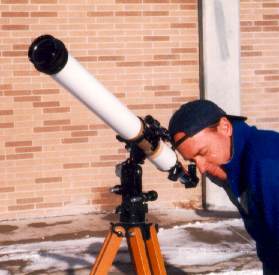
The best telescope for observations of planets (so they say) is the refractor
. In fact, this refractor gives a really sharp image of Saturn despite
its small aperture. The eyepiece is always at the end of the tube
and
that's where the observer needs to be - in this case biology instructor
Dave
Nash (a star in Sagittarius).
The refractor is also the first telescope that was invented. It's the
main design used for terrestrial observations.

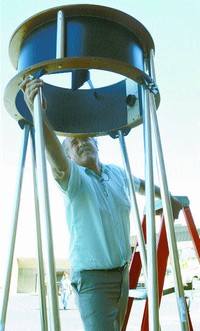
The "Dob" uses the same design as a Newtonian but it uses a mount
placed
on the ground.Here my former colleague
Doug Rice (Spanish Intructor at Blue Mountain Community
College in Penldeton, Oregon) assembles his oversized 18'' (450 mm)
Dob.
The photo shows the part and trusses holding the diagonal
secondary
mirror at the front of the telescope. The huge mirror is on the
ground.
(The picture links to a
Sept. 2002 article in Pendleton's local paper. )
The header links to a
Dob building web site (it's popular because with its simple mount
it can be built by any amateur astronomer). And this links to a
web site featuring
some Dob designs.
And this links to John Dobson's
web
site , the inventor of this type of telescope, founder of the "
Sidewalk Astronomers ", and apparently philosopher.
|
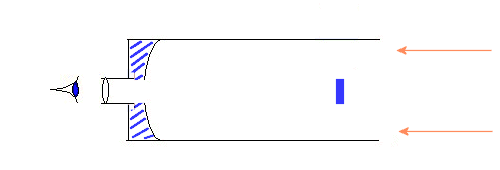

The other reflector type commonly used
by amateurs is the Cassegrain which has the eyepiece at the end
of the barrel (most major professional
telescopes are of this type). This means that there must be a hole in
the
objective mirror. This is not a disadvantage, since light is focused
from
all over the mirror. It simply cuts away a small percentage (less than
10%)
of brightness, but that was taken away by the secondary mirror, which
is
in the way anyway.
This particular reflector is actually called a Schmidt-Cassegrain
, because it has a correcting, thin lens covering the opening. Nothing
is
perfect, and so Cassegrains with spherical mirrors do not focus the
image
at exactly one point. The Schmidt lens gets rid of this blurring.
(The
college owns a C-8 and a C-5.) |
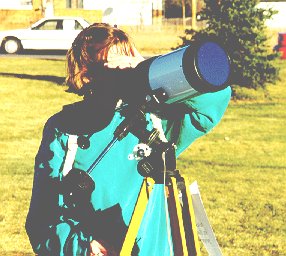 This is another
Schimdt-Cassegrain, a C-5. My wife Kate operates is
correctly with a solar filter on the front since this was November 15,
1999,
the day of the Mercury transit. This is another
Schimdt-Cassegrain, a C-5. My wife Kate operates is
correctly with a solar filter on the front since this was November 15,
1999,
the day of the Mercury transit.
|
|
Find a description and design image of
these telescopes at
Celestron.
And some images of this
telescope at
Orion.
The Coude design is rare and only used with large
professional
telescopes, such as the
Ondrejov telescope in the Czech Republic (just Southeast of Prague;
jointly used by Slovak astronomers as well).
Some telescopes can be easily redesigned to change them to a
Coude
fcous (third drawing on this web site).
The term "Prime focus" is often used by astrophotographers,
meaning to replace the eypiece with a camera. This is possible
with
any telescope. But a real "Prime Telescope" is rare: see this one
in
the Caucasus
Mts. in Russia (near the Black Sea) and notice how this astronomer
would hunches in the
prime focus cage of
California's Palomar telescope
.
Telescopes used in
the Astronomy labs at WNCC in Scottsbluff and Sidney, Nebraska,
and at KPC in Soldotna, Alaska
|
|
Design (Mount) |
Aperture |
Focal length |
f-stop
(divide focal length by aperture) |
apprx. price (includes
tripod) |
small orange
(mine in Alaska) |
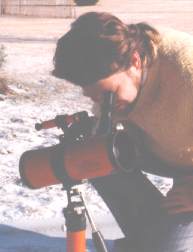 |
Newtonian (alt-azimuth) |
4'' (100 mm) |
~ 400 mm
|
f/4
|
$ 170
|
large orange
(Scottsbluff) |
 |
Schmidt-Cassegrain (equatorial) |
8'' (200 mm) |
2000 mm |
f/10 |
$ 1200 |
large black
(mine in Alaska)
|
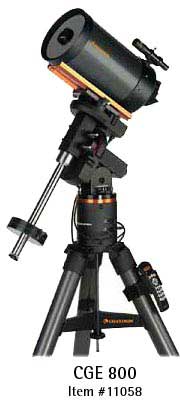
|
Schmidt-Cassegrain (equatorial)
|
8'' (200 mm)
|
2000 mm
|
f/10
|
$ 1000
|
small red
(KPC in Alaska)
|
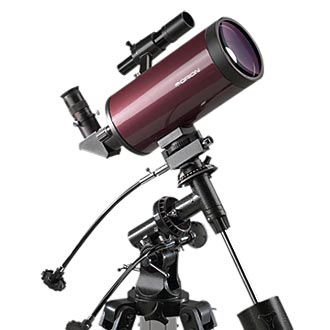
|
Maksutov-Cassegrain (equatorial)
|
4'' (102 mm)
|
1300 mm
|
f/12.7
|
$ 390
|
white
(Scottsbluff) |
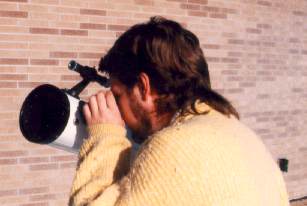 |
Newtonian (equatorial) |
4.5'' (114 mm) |
900 mm |
f/8 |
$ 460 |
white
(Sidney) |
 |
Refractor (alt-azimuth) |
2.4'' (60 mm) |
900 mm |
f/15 |
$ 200 |
white
(Scottsbluff) |
 |
Cassegrain (alt-azimuth) |
5'' (125 mm) |
1250 mm |
f/10 |
$ 700 (w/o tripod) |
Where are the largest telescopes in the world? See
the Sky & Telescope
July 1993 issue, I think.
Eyepieces available:
.965": 6mm, 9mm, 12mm, 18mm
1.25": 17mm, 25mm, 40mm
What property does an eyepiece determine?
Other equipment available (and its use):
Barlow-lens, color filter, Oxygen III filter
look through hand-outs (from
Orion Catalog , including prices)
Telescope Size (Properties)
List the (optical) features of a telescope: Aperture,
...
(see
King Observatory in Lincoln)
Powers of a telescope
- Light gathering power
Stars, nebulae, galaxies, quasars are faint.
So the most important purpose of an astronomical telescope must be to
make them as bright as possible. A bigger telescope (larger
aperture) collects more light, so telescopes are judged by their size
(aperture).

(The owl has large pupils, so that it can gather
more light (of the little that's there) during its night hunting.)
A camera, which usually has an aperture of 35 mm, can
gather more light by opening the shutter for a longer time. The left of
these
2 images of Scorpius was exposed for 2 sec, the one on the right for 20
sec.
Images (c) Andreas Veh.
- Resolving power
Larger aperture also produces sharper images.

(The eagle has large pupils, so it's able to
distinguish its prey from the surroundings as it's soaring high above
ground.)
(c) Martin Reble. One of my favorite objects,
M57, the Ring nebula in the constellation Lyra (whose really bright
star Vega
is part of the summer triangle). A telescope needs to have good
resolution, i.e. large aperture, before one can magnify an object to
enjoy it more.
For a nice example of resolving power and Hubble's superior
vision, check out my favorite Hubble
images . The first image shows Pluto and Charon imaged by Hubble before
its focus was restored. Compare this to the best photographs obtained
by
ground-based telescopes and to Hubble's refocusing.
- Magnification
The most misunderstood power takes only third
place. Before you magnify something, make sure that you get a
sharp image. Otherwise, what good does it do you when a planet
appears big, but blurry? And that's the case for cheap department
store telescopes. Resolving power depends on aperture, which thus
sets a limit to magnification. Beyond that ... blurry image.
(c) Hubble space Telescope. I altered the one
in
the middle. A small aperture refractor can show Saturn as it
appears
in the left image. The middle image shows how blurry it becomes
when
a higher power eyepiece is used on the same cheap department store
refractor. The image on the right shows the best image that can
be achieved with the college's 8 inch (aperture; 2000mm focal length)
Schmidt-Cassegrain with
a 2x Barlow lens and a 17mm eyepiece, at a magnification of 220x,
during
a night of exceptional seeing (no atmospheric turbulence) and Saturn
being
in opposition. Any more magnification would blur this image as
well.
Therefore large magnification can work only for large
aperture telescopes.
Magnification depends on the telescope's focal
length
and the eyepiece's focal length. Since the eyepiece can easily be
changed, magnification is changed as well all the time, and therefore
is not an inherent property of a telescope (the question "how much
magnification does this telescope have?" doesn't make sense).
(c) Royal Observatory Edinburgh. The Pleiades
(also called Seven Sisters) in Taurus are a beautiful sight for the
naked eye,
binoculars and low power telescopes. A large aperture telescope
can
only show parts of the Pleiades because its focal length is too long
(and
thus its magnification too large).
Magnification and Field of View are
in a trade off situation. You like to see some objects in their
entirety,
so why keep magnifying them? (Do you want to see
how
many enemies you have across the trench, or if one of them has a pimple
on
his forehead?) When looking at objects, you also always
start
out with a low power eyepiece, so you can easily find them.
Other Astronomies
Look at the following figures in your textbook:
(Chaisson/McMillan p.55), Fig.3.5 Electromagnetic
spectrum
p.57, Fig.3.6 Electromagnetic spectrum
p.61, Fig.3.9 The Sun in different parts of the
EM-spectrum
p.101, Fig.4.30 The Milky Way in diff. parts of the
EM-spectrum
and
these figures on the internet .

- Radio
Arecibo , Puerto Rico.
Very
Large
Array , New Mexico. Photos taken by Daniel
Woods, Sidney, NE, spring 2002 astronomy student.
- Infrared
FIRST - The Far Infra-Red and Submillimetre Telescope
IRAS
ISO - Infrared Space Observatory
WIRE - Wide Field Infrared Explorer (Start: 3/1999)
SIRTF - Space InfraRed Telescope Facility (Start: 2002)
- Visible
Hubble Space Telescope , orbiting
at an average 400 miles above Earth's surface.
Keck Observatory, Hawaii.
Subaru Observatory, Hawaii.
Very Large Telescope, Chile.
Mount Palomar, California.
Kitt Peak, Arizona.
Your Backyard!
- Ultraviolet
IUE (1978-1996)
EUVE - Extreme Ultraviolet Explorer (1992-...)
ORFEUS - Orbitales und Rückführbares Fern- und Extrem-
Ultraviolett Spektrometer (1993/1996)
FUSE - Far Ultraviolet Spectroscopic Explorer (1999)
- X-rays
Chandra X-ray
Observatory , orbiting at an average 40,000 miles above
Earth's surface.
BeppoSAX , orbiting at
an average 400 miles above Earth's surface.
ROSAT , an average
...
Exosat
HEAO 1 - 1st High Energy Astrophysics Observatory
HEAO 2 - 2nd High Energy Astrophysics Observatory = Einstein
- [MPE] - [GSFC] - [Leicester]
- [ROSAT Results Archive (RRA) at AIP] - [RRA at MPE] - [RRA at GSFC
(ftp)]
ASCA (1993-....)
ABRIXAS (geplanter Start: 1999)
Astro-E (geplanter Start: 2000)
XMM (geplanter Start: 2000)
- [XMM Science Operation Centre at ESA] - [XMM Survey Science Centre at
Leicester] - [XMM Survey Science Centre at AIP] - [XMM Survey Science
Centre at MPE]
- Gamma rays
 The Milky Way in
gamma-rays, 1999 hologram stamp by the
German Postal Services .
The Milky Way in
gamma-rays, 1999 hologram stamp by the
German Postal Services .
COS-B (1975-1982) - [ at HEASARC]
Compton Gamma Ray Observatory, an average ..
- [COMPTEL] - [BATSE] - [EGRET] - [OSSE]
INTEGRAL - International Gamma-Ray Astrophysics Laboratory
(geplanter Start: 2.04.2001)
GLAST - Gamma-ray Large Area Space Telescope (Start: 2005)
For links see here: http://home.t-online.de/home/SWeimer/astro.htm
Also:
ASTROMETRY
Hipparcos (1989-1993)
GAIA (preliminary concept, launch could be in 2014)
MIKROWAVES
COBE - Cosmic Background Explorer (1989-....)
Planck (COBRAS/SAMBA)
To my WNCC
Astronomy home page .
 Every telescope has a finder
(also called spotting scope). You
need to start out with this to find the right object (makes
sense,
right?). The finder gives you a wider field of view: Since
stars
etc. move slower through the field when you slew the telescope, it's
easier
to point at the right star/ planet/ nebula/ galaxy.
Every telescope has a finder
(also called spotting scope). You
need to start out with this to find the right object (makes
sense,
right?). The finder gives you a wider field of view: Since
stars
etc. move slower through the field when you slew the telescope, it's
easier
to point at the right star/ planet/ nebula/ galaxy. 

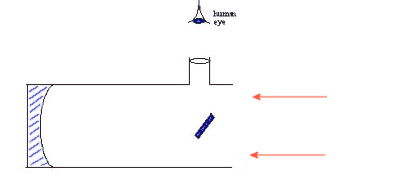

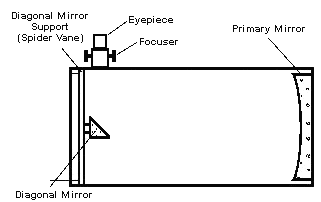
 Most major telescopes
nowadays (especially professional ones) are reflectors . Since
here the objective mirror is always at the end of the barrel, it
can be easily supported, which is a major advantage over refractors.
All
reflectors (except prime focus) have a secondary mirror in
common.
Its purpose is to redirect the received light out of the telescope, so
an
object can be viewed.
Most major telescopes
nowadays (especially professional ones) are reflectors . Since
here the objective mirror is always at the end of the barrel, it
can be easily supported, which is a major advantage over refractors.
All
reflectors (except prime focus) have a secondary mirror in
common.
Its purpose is to redirect the received light out of the telescope, so
an
object can be viewed. 


 This is another
Schimdt-Cassegrain, a C-5. My wife Kate operates is
correctly with a solar filter on the front since this was November 15,
1999,
the day of the Mercury transit.
This is another
Schimdt-Cassegrain, a C-5. My wife Kate operates is
correctly with a solar filter on the front since this was November 15,
1999,
the day of the Mercury transit.











 The Milky Way in
gamma-rays, 1999 hologram stamp by the
German Postal Services .
The Milky Way in
gamma-rays, 1999 hologram stamp by the
German Postal Services .